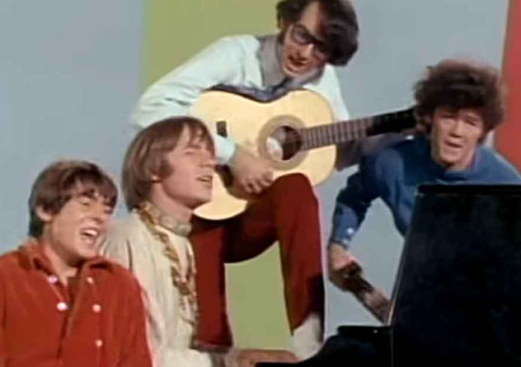About The Song
Background
“Daydream Believer” is one of the most iconic songs by The Monkees, an American pop-rock band formed in the 1960s for a television series of the same name. Written by John Stewart of The Kingston Trio, the song was released in 1967 and became a massive hit, reaching number one on the Billboard Hot 100 chart. The Monkees, consisting of Davy Jones, Micky Dolenz, Michael Nesmith, and Peter Tork, were at the height of their popularity when “Daydream Believer” was released, and the song played a significant role in cementing their status as pop culture icons.
The song’s release came at a time when The Monkees were transitioning from being perceived solely as a TV band to being recognized as legitimate musical artists. “Daydream Believer” was included on their fourth album, “The Birds, The Bees & The Monkees,” which saw the band taking more control over their music production and composition. This period marked a crucial point in their career, as they sought to break free from the constraints of their television show and establish themselves as a serious musical group.
Musical Style
“Daydream Believer” is a classic example of 1960s pop music, characterized by its upbeat melody, catchy chorus, and lush orchestration. The song features a blend of pop and rock elements, with a prominent piano line played by Peter Tork, which serves as the song’s musical foundation. The arrangement includes rich harmonies, vibrant brass sections, and a string arrangement that adds a layer of sophistication to the track.
Davy Jones’s lead vocals are a highlight of the song, delivering the lyrics with a sense of whimsy and charm that complements the song’s theme of daydreaming and idealized love. The production, handled by Chip Douglas, is polished and professional, reflecting the high standards of pop music production in the late 1960s. The use of orchestral elements in the arrangement gives the song a grand and timeless feel, making it stand out in The Monkees’ discography.
Lyrics
The lyrics of “Daydream Believer” tell the story of a man reflecting on his life and relationship with a sense of nostalgic yearning. The song opens with the memorable lines:
“Oh, I could hide ‘neath the wings of the bluebird as she sings, the six o’clock alarm would never ring.”
These lines set the tone for the song, evoking a sense of longing for a simpler, more carefree time. The chorus, with its infectious melody, reinforces this theme of daydreaming and escapism:
“Cheer up, sleepy Jean, oh, what can it mean to a daydream believer and a homecoming queen?”
The lyrics capture the essence of youthful dreams and the bittersweet nature of growing up and facing reality. The contrast between the dreamy verses and the upbeat chorus creates a dynamic that resonates with listeners, allowing them to connect emotionally with the song’s narrative.
Cultural Impact
“Daydream Believer” has had a significant impact on popular culture since its release. As one of The Monkees’ most successful and enduring hits, the song has been covered by numerous artists across various genres, including Anne Murray, Sheryl Crow, and Susan Boyle. Its timeless appeal and catchy melody have made it a staple of oldies radio and a beloved classic for multiple generations.
The song’s association with The Monkees’ television show has also contributed to its cultural legacy. The show, which aired from 1966 to 1968, was a groundbreaking blend of comedy, music, and innovative filming techniques. “Daydream Believer” often featured in episodes, further embedding it in the minds of fans. The Monkees’ unique blend of humor, charm, and musical talent made them a phenomenon of the 1960s, and “Daydream Believer” was a key part of that success.
In addition to its musical impact, “Daydream Believer” has been used in various films, TV shows, and commercials, underscoring its continued relevance in popular media. Its cheerful, optimistic tone makes it a popular choice for scenes that require a sense of nostalgia or a feel-good atmosphere.
Conclusion
“Daydream Believer” remains one of the most beloved songs of the 1960s, a testament to The Monkees’ lasting influence on pop music and culture. The song’s blend of catchy melodies, thoughtful lyrics, and polished production has ensured its place in the pantheon of classic pop hits. The Monkees, originally conceived as a fictional band for a TV show, transcended their origins to become genuine musical artists, and “Daydream Believer” is a shining example of their talent and appeal.
The song’s enduring popularity can be attributed to its universal themes of love, nostalgia, and the tension between dreams and reality. Its ability to evoke a sense of longing for simpler times while maintaining an upbeat and optimistic tone has made it a favorite for generations of listeners. As long as there are dreamers and believers, “Daydream Believer” will continue to resonate and bring joy to audiences around the world.
Video
Lyrics
Let’s sing along with the lyrics!
Oh, I could hide ‘neath the wings
Of the bluebird as she sings
The six o’clock alarm would never ring
But it rings and I rise
Wipe the sleep out of my eyes
My shavin’ razor’s cold and it stings
Cheer up, Sleepy Jean
Oh, what can it mean
To a daydream believer
And a homecoming queen
You once thought of me
As a white knight on his steed
Now you know how happy I can be
Oh, and our good times start and end
Without dollar one to spend
But how much, baby, do we really need
Cheer up, Sleepy Jean
Oh, what can it mean
To a daydream believer
And a homecoming queen
Cheer up, Sleepy Jean
Oh, what can it mean
To a daydream believer
And a homecoming queen
[Instrumental interlude]
Cheer up, Sleepy Jean
Oh, what can it mean
To a daydream believer
And a homecoming queen
[Repeat and fade]
















